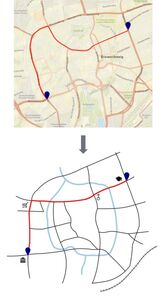
Visual Communication to Control Route Choice Behavior

When navigating from one location to another, the individual decision for a certain route usually depends on various factors and circumstances including time, distance or complexity, but also the current or expected traffic density. Since the traffic volume in urban environments increases rapidly, in many cases the road network cannot cope with the growing number of vehicles any longer. As a consequence, road users and inhabitants need to face problems like traffic jam, air pollution and an increasing risk of accidents. We may argue that these problems are also caused by a non-optimal distribution of vehicles within the road network. If we want to improve the overall traffic flow, it is important for the traffic management to make road users aware of optimal route alternatives, e.g. to reduce congestion and to use of the road network more efficiently. However, the question is, how can we communicate the efficiency of a route, so that the road user will be convinced to decide for the recommended route, even though it might not appear to be efficient at first glance?
Current navigation systems propose different routes – visualized on maps, which show all detail information. Research in cognitive psychology suggests that people mentally abstract the geographic space when they communicate routes to others (e.g. when drawing a sketch map), focusing only on the most relevant information necessary for navigation. Based on these concepts, the hypothesis is that a clearer representation of the route may not only simplify the communication of the relevant route information, but also influences route choice behavior.
In the scope of the project, different approaches of visually recommending efficient routes will be developed as part of a framework to automate the visualization process. In this context, different cartographic generalization techniques will be applied, including feature selection, simplification, schematization or distortion of map objects; but also the use of symbolization and graphical variables. The efficiency of the different visual concepts will be evaluated in close cooperation with experts from psychology, e.g. by performing user studies.
Researcher: Stefan Fuest, M. Sc.